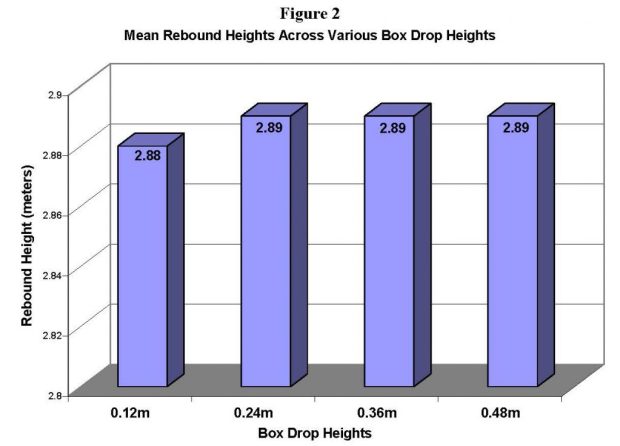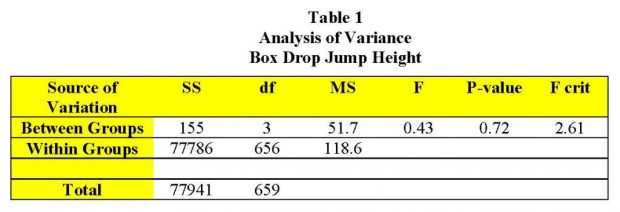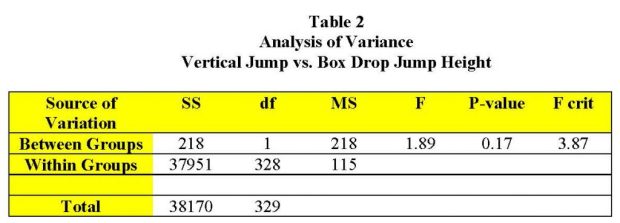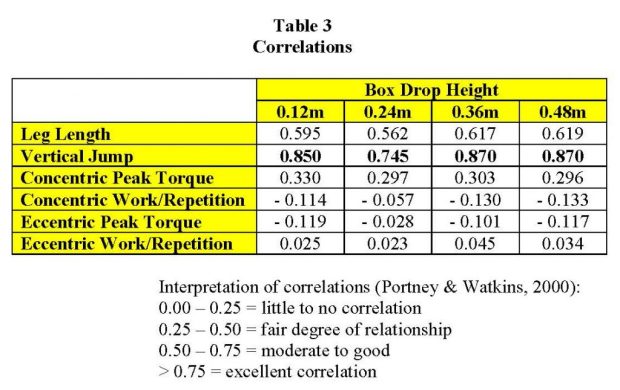Abstract
Plyometric activities use rapid switching from eccentric to concentric contractions to increase speed or force of muscle contractions. Training the stretch-shorten cycle by jumping enhances athletic performance. This study sought optimal box heights athletes could drop from to obtain maximal rebound height. Division-III collegiate football players (n = 55) older than18, weighing no more than 100 kg, and with no lower-extremity injury were the participants. Initial data collected measured height, weight, leg length, age, standing vertical jump, and quadriceps strength. Peak torque and work per repetition were calculated for eccentric and concentric quadriceps activity. Participants completed 3 box drops from each of 4 different box heights as vertical rebound was measured. ANOVA showed rebounds did not differ significantly by box height, nor did rebound from any height differ significantly from standing vertical jump. Little to no correlation (Pearson’s r < 0.25) was found between vertical rebound from any height and concentric or eccentric work per repetition or eccentric peak torque. Fair correlation (Pearson’s r = 0.29–0.33) was found between concentric peak torque and vertical rebound from all heights. Leg length correlated moderately (Pearson’s r = 0.56–0.61) with vertical rebound from all heights. Because results indicate greater box drop height is not statistically associated with greater vertical rebounds, using a box height above 0.12 m (the shortest tested here) is likely to increase injury risk without providing any accompanying benefits. The study is limited by the fact that jumping technique was not included as a variable, although clearly technique could be a component in rebounding.
Parameters That Influence Vertical Jump Height
Jumping is a simple plyometric task required in a variety of athletic activities. Plyometric exercise uses the stretch-shorten cycle to train muscles to do more work in less time (Holcomb, Lander, Rutland, & Wilson, 1996; Komi, 1978). In plyometric activities, muscles rapidly switch from an eccentric action to a concentric contraction, essentially leaving no time for the muscle to relax. Stored elastic energy in the muscle and the stretch reflex summate to permit the muscle to create greater force (Hedrick & Anderson, 1996; Holcomb et al., 1996; Komi, 1988; McNeely, 2005; Wagner & Kocak, 1997).
In a recent survey of training preferences, 94% of college strength and conditioning coaches reported using plyometric training (Durell, Pujol, & Barnes, 2003). Tasks such as vertical jumps, hops, and/or bounding movements are often used to increase explosiveness and strength of the lower extremities (Ebben, 2005; McNeely, 2005). Research has attempted to identify the particular drop-jumping height that produces greatest gains in vertical jump (Bobbert, 1990; Lees & Fahmi, 1994; Walsh, Arampatzis, Schade, & Bruggemann, 2004). Lees and Fahmi (1994) reported maximal rebound height occurred at drops of 0.12 m; maximal vertical forces occurred at 0.36 m; and maximal vertical velocity occurred at 0.12 m. Asmussen and Bonde-Peterson (1974) reported optimal drop height was 0.4 m. Voigt and colleagues (1995) found a 0.3-m drop height produced significantly higher jump heights than at 0.6 m or 0.9 m. Komi and Bosco (1978) reported that rebound height continued to increase up to a drop height of 0.6 m for males and 0.5 m for females. Conversely, Bobbert and associates (1987a, 1987b) found no significant difference in rebound height at drop heights of 0.2 m, 0.4 m, and 0.6 m; peak force did increase, they noted, as drop height increased.
While many athletes believe that large drop heights are needed to achieve maximal gains in the rebound vertical jump, in fact rebounding technique can deteriorate at greater drop heights, leading in turn to greater impact forces and increased risk of injury (Bobbert, 1990). This study sought to determine how the rebound height of a vertical jump was related to drop height as well as to athletes’ physical characteristics. The researchers hypothesized the following:
- Concentric and eccentric quadriceps strength is highly correlated to vertical jump height.
- Stronger athletes achieve higher maximal rebound jump heights from higher drop heights.
Method
Participants
Recruitment of Division-3 collegiate football players was approved by Widener University’s institutional review board. The sample comprised 55 participants (age 19.1 ± 1.4 years; height 180.5 ± 5.2 cm; weight 87.3 ± 9.1 kg) who met three inclusion criteria: age above 18 years, weight no more than 100 kg (220 lb), and freedom from lower-extremity injury. Athletes weighing more than 100 kg (220 lb) were excluded from data collection as recommended by the National Strength and Conditioning Association (Baechle, 1994).
Procedures
Data collected from each participant included age in years, height and leg length in centimeters, weight in kilograms, standing vertical jump, and quadriceps muscle strength. Leg length was assessed using a meter stick. Each participant was instructed to place one end of the meter stick in the most proximal aspect of the groin, and the measurement was taken at the most distal aspect of the heel. Height and weight were assessed on a standard scale. A Vertec™ measurement system (manufactured by Power Systems of Knoxville, Tennessee) was used to measure standing vertical jump with a one-step approach. A Biodex™ isokinetic dynamometer (manufactured by Biodex Corporation of Shirley, New York) was used to assess concentric and eccentric quadriceps muscle strength. Each participant’s dominant lower extremity was tested, with trunk stabilized in a seated position and arms folded across chest. Each participant performed five concentric repetitions at 240°/s; maximal peak torque and maximal work per repetition were measured for use in data analysis. The participant then rested for 1 min before five eccentric repetitions were performed at 120°/s; again, maximal peak torque and maximal work per repetition were measured.
Each participant was instructed in the proper box drop technique and given the opportunity to practice while receiving feedback. The standardized technique used required the athletes to step off the drop box platform, land both feet simultaneously on the floor, and immediately rebound upward with a maximal effort, as high as possible (Figure 1). Participants completed three box drops from each of four box heights: 0.12 m, 0.24 m, 0.36 m, 0.48 m; a rest lasting at least 10 s occurred between jumps (Ebben, 2005). All vertical rebound heights were measured with the Vertec™ measurement system.
Analysis
Analysis of variance (ANOVA) was performed on data describing participants’ standing vertical jumps and rebound jumps from the four box drop heights. Correlations were performed between the mean of each box drop jump height and the following independent variables: leg length, vertical jump, concentric peak torque, concentric work per repetition, eccentric peak torque, and eccentric work per repetition.
Results
The mean rebound jump heights, with standard deviations, were 2.88 ± 1.02 m, 2.89 ± 1.21 m, 2.89 ± 1.04 m, and 2.89 ± 1.08 m, at box drop heights of 0.12 m, 0.24 m, 0.36 m, and 0.48 m, respectively (Figure 2). ANOVA revealed no significant difference (p = 0.72) in vertical jump height among the four box drop rebound heights (Table 1). Moreover, there was no significant difference (p = 0.17) in standing vertical jump (2.91 ± 1.07 m) and any of the box drop rebound heights (Table 2). An excellent Pearson correlation (r > 0.75) was obtained for standing vertical jump and all box drop rebound heights (Table 3). Moderate correlations were evident between leg length and all box drop rebound heights (Pearson’s r = 0.56-0.61), but only fair correlations were found between concentric peak torque and all box drop rebound heights (Pearson’s r = 0.29–0.33). Finally, there were few if any correlations between vertical rebound from any height and concentric or eccentric work per repetition or eccentric peak torque (Pearson’s r < 0.25) (Portney & Watkins, 2000).





Note. Concerning correlations, Portney and Watkins (2000) state that 0.00–0.25 indicates little to no correlation, 0.25–0.50 indicates a fair degree of relationship, 0.50–0.75 indicates moderate to good relationship, and > 0.75 indicates excellent correlation.
Discussion
In the current study, vertical rebound height achieved was slightly greater as the height of the box drop increased, although the increase was not statistically significant (p = 0.72). These results are consistent with Lees and Fahmi’s earlier findings (1994) in a study of 30 male athletes performing drops from six different box heights (0.12 m, 0.24 m, 0.36 m, 0.46 m, 0.58 m, and 0.68 m). Lees and Fahmi reported the optimal drop height to be 0.12 m, for all measured parameters (maximum rebound height, maximum vertical force, maximum vertical velocity, height rise of the center of gravity, and instantaneous power output).
Although prior researchers (Bobbert, 1990; Walsh et al., 2004) have emphasized the influence of jumping technique on the resultant height of the rebound vertical jump, the present study did not attempt to alter participants’ self-selected rebound techniques. They were simply told to “drop off each box by stepping forward, landing simultaneously on both feet, and immediately rebound upward as high and as fast as possible.” Walsh et al. (2004) studied the responses of 15 male athletes to drop heights of 0.2 m, 0.4 m, and 0.6 m, reporting that contact time of the feet with the floor (amortization) had a greater effect on rebound height than did starting drop height. In drops with moderate contact times (161–166 ms), the quadriceps of the knee was found to contribute 37% of the total power. However, the quadriceps was reported to generate only 28% of total power when contact times were shorter (136–152 ms). Thus, even though contact time was not assessed for the present research, it was confounding that quadriceps muscle strength did not display a higher correlation to rebound height.
Neither concentric or eccentric peak torque nor work per repetition demonstrated more than a fair correlation to rebound jump height. We anticipated that eccentric quadriceps strength would be important for accumulating potential energy upon landing and subsequently converting it to kinetic energy used in a vertical jump. We further theorized that when one athlete possessed greater eccentric quadriceps strength than another, the stronger athlete would be able to absorb more force on landing and translate it into a higher rebound height. No such relationship was identified in the current study.
It has been demonstrated that as plyometric tasks are performed, forces on the lower extremities can reach levels 15 times an individual’s body weight (Perttunen, Kyrolainen, Komi, & Heinonen, 2000). Since maximal power is generally achieved when working with loads 30%–70% of maximum, it follows that athletes possessing greater quadriceps muscle strength would be likelier than other athletes to work successfully within this recommended range to achieve optimal plyometric results (Warpeha, 2005). Lephart, Ferris, Riemann, Myers, and Fu (2002) examined the influence of kinematics, vertical ground reaction forces, and strength during the landing of plyometric tasks. They concluded that weak quadriceps musculature may be insufficient to decelerate the body when landing. As a result, landing may occur on a more extended knee, with greater hip internal rotation. These alterations of landing posture may place the lower extremity in a poor biomechanical position to appropriately distribute and absorb the impact forces.
A limitation of the present study is its lack of measures for contact time with the floor, or amortization (made using force-plate instrumentation). In the absence of such measures, we were unable to determine if contact time was a more significant factor than box drop height. Another limitation of our study was participants’ lack of training sessions focusing on specific jumping and landing techniques. Research has shown that athletes skilled in jumping activities demonstrate increased ankle plantar flexion (McKinley & Pedotti, 1992; McNitt-Gray, 1993), increased knee flexion (McNitt-Gray, 1993; Viitasalo, Salo, & Lahtinen, 1998), and decreased ground reaction forces (Prapavessis & McNair, 1999; Viitasalo, Salo, & Lahtinen, 1998).
In summary, the current study found that increased height of box drops did not result in significantly greater vertical jumps. Optimal rebound jump height occurred from the lowest drop height tested (0.12 m); thus no concurrent benefit in vertical jump height would accompany the higher risk of injury that may be seen with increased height of box drops. Technique may be a critical component in achieving a maximal box drop.
References
Asmussen, E., & Bonde-Peterson, F. (1974). Storage of elastic energy in skeletal muscles in man. Acta Physiologica Scandinavia, 92, 385–392.
Baechle, T. R. (1994). Essentials of strength training and conditioning. Champaign, IL: Human Kinetics.
Bobbert, M. F. (1990). Drop jumping as a training method for jumping ability. Sports Medicine, 9(1), 7–22.
Bobbert, M. F., Huijing, P. A., & Van Ingen Schenau, G. J. (1987a). Drop jumping 1: The influence of jumping technique on the biomechanics of jumping. Medicine and Science in Sports and Exercise, 19, 332–338.
Bobbert, M. F., Huijing, P. A., & Van Ingen Schenau, G. J. (1987b). Drop jumping 2: The influence of jumping technique on the biomechanics of jumping. Medicine and Science in Sports and Exercise,19, 339–346.
Bosco, C., Viitasalo, J., Komi, P. V., & Luhtanen, P. (1982). Combined effect of elastic energy and myoelectrical potentiation during stretch-shorten cycle exercise. Acta Physiologica Scandinavia, 114, 557–565.
Durell, D., Pujol, T., & Barnes, J. A (2003). Survey of the scientific data and training methods utilized by collegiate strength and conditioning coaches. The Journal of Strength and Conditioning Research, 17(2), 368–373.
Ebben, W. P. (2005). Practical guidelines for plyometric intensity. NSCA’s Performance Training Journal, 6(5), 12–16.
Hedrick, A., & Anderson, J. C. (1996). The vertical jump: A review of the literature and a team case study. Journal of Strength and Conditioning, 22(5), 70–74.
Holcomb, W., Lander, J., Rutland, R., & Wilson, D. (1996). The effectiveness of a modified plyometric program on power and the vertical jump. The Journal of Strength and Conditioning Research, 10(2), 88–92.
Komi, P. V., & Bosco, C. (1978). Utilization of stored elastic energy in leg extensor muscles by men and women. Medicine and Science in Sports and Exercise. 10, 261–265.
Lees, A., & Fahmi, E. (1994). Optimal drop heights for plyometric training. Ergonomics, 37(1), 141–148.
Lephart, S. M., Ferris, C. M., Riemann, B. L., Myers, J. B., & Fu, F. H. (2002). Gender differences in strength and lower extremity kinematics during landing. Clinical Orthopedics and Related Research, 401, 162–169.
McKinley, P., & Pedotti, A. (1992). Motor strategies in landing from a jump: The role of skill in task execution. Experimental Brain Research, 90, 427–440.
McNeely, E. (2005). Introduction to plyometrics: Converting strength to power. NSCA’s Performance Training Journal, 6(5), 19–22.
McNitt-Gray, J. L. (1993). Kinetics of the lower extremities during drop landings from three heights. Journal of Biomechanics, 26, 1037–1046.
Perttunen, J., Kyrolainen, H., Komi, P. V., & Heinonen, A. (2000). Biomechanical loading in the triple jump. Journal of Sports Sciences, 18, 363–370.
Portney, L. G., & Watkins, M. P. (2000). Foundations of clinical research: Applications to practice. Upper Saddle River, NJ: Prentice-Hall.
Prapavessis, H., & McNair, P. J. (1999). Effects of instruction in jumping technique and experience jumping on ground reaction forces. Journal of Orthopedics and Sports Physical Therapy, 29, 352–356.
Viitasalo, J. T., Salo, A., & Lahtinen, J. (1998). Neuromuscular functioning of athletes and non-athletes in the drop jump. European Journal of Applied Physiology, 78, 432–440.
Voigt, M., Simonsen, E. B., Dyhre-Poulsen, P., & Klausen, K. (1995). Mechanical and muscular factors influencing the performance in maximal vertical jumping after different prestretch loads. Journal of Biomechanics, 28, 293–307.
Wagner, D., & Kocak, M. (1997). A multivariate approach to assessing anaerobic power following a plyometric training program. The Journal of Strength and Conditioning Research, 11(4), 251–255.
Walsh, M., Arampatzis, A., Schade, F., & Bruggemann, G. P. (2004). Effect of drop jump starting height and contact time on power, work performed, and moment of force. Journal of Strength and Conditioning Research, 18(3), 561–566.
Warpeha, J. M. (2005). Upper body plyometrics. NSCA’s Performance Training Journal, 6(5), 6–8.

